Cranes play a key role on construction sites, lifting heavy materials and supporting tasks that shape skylines. While many things affect crane performance, wind is one factor that must always be monitored. This is where the crane anemometer comes in. It may look like a simple device, but it carries a big responsibility when it comes to keeping job sites safe.
What Does a Crane Anemometer Do?
A crane anemometer is a wind speed sensor. It tracks the speed of the wind and often the direction as well. This data helps operators decide if it’s safe to continue lifting operations or if work should pause. Most modern anemometers on cranes are digital and can give real-time feedback, which is especially helpful when working at height.
Some systems include alarms that warn the operator if wind speeds reach a level that could affect crane balance or control. In those cases, lifts might be delayed until conditions settle. These alerts can prevent tipping, swaying, or dropping loads that could harm people and property.
Why Wind Affects Crane Operation
Cranes are built to be strong and precise, but they can still be affected by weather. Wind can create side loads on the boom, cause a swinging load to move off path, or even push the whole crane structure in extreme situations. Tall tower cranes are especially sensitive because they have large surface areas and sit high in the air.
Even mobile cranes, which are lower to the ground, need to watch wind conditions when using long booms or lifting bulky materials. Flat surfaces such as sheet metal or large wall panels can attract wind like a sail, causing the load to deviate from its original alignment.
Ignoring wind risks could cause a load to spin, hit another structure, or fall. These are all hazards that can lead to delays, injuries, and in worst cases, fatalities. The anemometer gives crane teams the information they need to avoid these risks.
How Wind Speed Sensors Improve Safety
Wind speed sensors support crane wind safety in several ways. First, they offer clear data. Guessing wind speed by feel or sight is risky and often wrong. The anemometer gives an exact number that can be used in decision-making.
Second, they reduce the chance of human error. When alarms are tied to preset limits, workers don’t need to keep checking the wind themselves. The system will alert them when action is needed. That consistency can make a difference in a fast-paced environment.
Third, they help teams stay in line with safety standards. Most crane manuals include wind speed limits. These limits are not just suggestions. They are based on tests that show when lifting becomes unsafe. The anemometer helps confirm that work stays within those limits.
Finally, they improve planning. Site managers can use wind data to schedule lifts during calmer times. If gusts are expected in the afternoon, heavy lifts can be moved to the morning. That reduces delays and makes the site more efficient.
Types of Crane Anemometers
Several kinds of wind speed sensors are used on cranes. The most common type has small cups that spin when the wind blows. The faster the spin, the higher the wind speed. Others may use ultrasonic sensors that measure the time it takes for sound waves to travel between sensors, which changes with wind.
Some anemometers are mounted on the top of the crane’s boom. Others are placed lower, though this can affect accuracy. Wireless models are popular because they are easier to install and send readings directly to a control screen or handheld device.
Advanced systems can be linked to the crane’s control panel or even to cloud software that logs wind history. This gives project managers a record of weather conditions throughout the job, which can be useful for safety reports or inspections.

Where the Anemometer Fits in Daily Crane Use
Operators often start their shift by checking the crane’s systems, and the anemometer should be part of that process. The screen that shows wind speed should be tested to make sure it works properly. If the sensor has moved or been damaged, the readings might be off, which can be dangerous.
During lifts, the operator watches the display for sudden changes. Wind can rise quickly, especially on open sites or near tall buildings that create wind tunnels. Spotters and lift directors also use wind data to judge when to lift or wait.
Some sites post the wind speed limits next to the control area, making it easy for everyone to see when work needs to stop. That level of awareness builds trust and teamwork between ground crews and crane operators.
Training and Awareness
Anemometers are only helpful when people know how to use them. That means operators and supervisors need training on what the numbers mean and how wind affects different types of lifts. A ten-mile-per-hour wind might not seem strong, but it could shift a long load enough to create danger.
Some companies run wind safety drills, using past wind data to talk through decisions. This gives crews the confidence to stop a lift if they feel it’s unsafe, even if the site is under pressure to meet deadlines.
What Happens if Wind Data is Ignored?
Skipping the wind check can have serious consequences. There have been incidents where high wind caused cranes to collapse, loads to swing into nearby structures, or rigging to fail mid-air. Most of these events could have been avoided with better weather monitoring.
Wind does not need to be strong to be risky. Sudden gusts or swirling currents can throw off a lift, especially when the crane is working close to its capacity. The crane anemometer helps catch those changes before they cause damage.
Supporting a Culture of Safety
Using a crane anemometer is not just about following rules. It shows a mindset that puts safety first. Teams that check wind speed every day are also more likely to double-check rigging, inspect the ground for stability, and follow communication signals closely.
That kind of culture keeps everyone safer, from the workers on the ground to the people walking by a site. It also protects equipment from damage and helps avoid costly downtime.
Choosing the Right Anemometer
Different jobs call for different tools. When selecting a crane anemometer, it helps to look at a few key features. The sensor should be accurate, durable, and able to work in harsh weather. Wireless options are often easier to maintain and install.
It’s also helpful to choose a system that shows readings in a simple format. A clear display with warning lights or sounds helps operators react quickly. Some advanced models even stop the lift automatically if wind speeds cross the set limit.
Maintenance also matters. Sensors should be checked often and cleaned if needed. Dust or ice buildup can cause false readings. During the daily inspection, teams should also look for damage to cables or the mounting bracket.

Why It Matters at Every Site
No matter the size of the crane or the job, wind is always a factor. The higher and longer the lift, the more impact wind can have. Even small shifts in air pressure can change how a load moves once it is in the air.
The crane anemometer gives teams a simple way to stay ahead of those changes. It removes guesswork and builds confidence in every lift. Knowing the wind conditions gives crews a real advantage, whether they are placing steel beams, lifting HVAC units, or working near power lines.
Cranes are powerful tools, but they must be respected. The anemometer plays a quiet but steady role in making sure that power is used safely.
Final Thoughts
Wind is invisible, but its effects are very real. When working with cranes, every detail counts, and the crane anemometer is one of the most important tools on site. It offers data that helps avoid mistakes, keeps crews safe, and keeps projects on schedule.
Good crane safety starts with knowledge. The wind speed sensor gives that knowledge in real time, allowing crane operators to make better decisions. Every crane should have a well-functioning and frequently checked wind speed sensor.
At Bigfoot Crane Company, we understand the value of dependable lifting solutions. Whether managing tower cranes, mobile units, or specialty equipment, a well-maintained anemometer can make the difference between a smooth lift and a risky one. Take the time to check your system, understand the numbers, and never underestimate what the wind can do.





